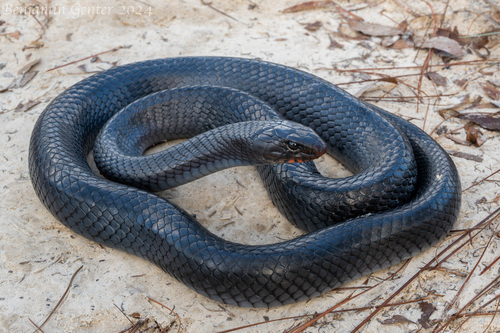
Eastern Indigo Snake
The Eastern Indigo Snake, Drymarchon couperi, is a striking, non-venomous predator known for its glossy black-blue sheen. Native to the southeastern U.S., it inhabits diverse ecosystems and controls rodent populations, even preying on venomous snakes. Its impressive size and gentle nature make it a fascinating species.
4.99 kg
Weight
Length: 2.5908 m
Size
Red, Blue, Black, Cream, Orange, Purple
Color
Least Concern
Conservation Status
Decreasing
Population Trend
Characteristics
The Eastern Indigo Snake (Drymarchon couperi) is a large, non-venomous snake native to the southeastern United States. It boasts a glossy, iridescent black-blue coloration and can reach lengths of up to 8 feet. This snake thrives in a variety of habitats, including pine flatwoods and hardwood forests, and is known for its gentle demeanor despite its size. It plays a crucial role in controlling rodent populations and is particularly noted for preying on venomous snakes like rattlesnakes.
Distribution Range of the Eastern Indigo Snake
The Drymarchon couperi, commonly known as the Eastern Indigo Snake, is native to the southeastern United States. Its geographical distribution primarily includes the states of Florida and Georgia, with historical ranges extending into Alabama and southern Mississippi.
Eastern Indigo Snake's Habitat
Environmental Conditions
Eastern Indigo Snakes typically inhabit a variety of ecosystems, including pine flatwoods, tropical hammocks, and sandhill environments. These areas are characterized by warm, temperate climates with well-drained sandy soils. The habitat often includes open canopies and dense ground cover, which provide ample opportunities for hunting and shelter.
Ecological Niche
As a top predator, the Eastern Indigo Snake plays a crucial role in controlling the populations of small mammals, birds, amphibians, and other reptiles, including venomous snakes. Its ecological niche involves being an active forager, often moving between different habitats to find prey and suitable shelter, particularly during colder months when it seeks refuge in the burrows of gopher tortoises or other animals.
Copyright @ Nature Style Limited. All Rights Reserved.
 English
English